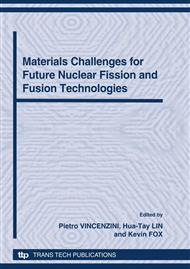p.130
p.136
p.142
p.148
p.158
p.171
p.176
p.183
p.194
Development of New Waste Forms to Immobilize Iodine-129 Released from a Spent Fuel Reprocessing Plant
Abstract:
I-129 is a very long-lived radionuclide that is released to an off-gas stream when spent fuels are dissolved at a reprocessing plant. An iodine filter can capture I-129 in the form of AgI. However, because AgI is unstable under the reducing conditions of a geological repository and I-129 has a very long half-life, I-129 can migrate to the biosphere. These characteristics make I-129 a key radionuclide for the safety assessment of a geological disposal of radioactive wastes generated from a reprocessing plant (TRU wastes). To improve disposal safety, several new waste forms have been developed to confine I-129 for a very long period in order to reduce the leaching of I-129 from radioactive wastes. These new waste forms have technical objectives of solidifying more than 95% of I-129 into the waste form and achieving a leaching rate of less than 10-5/y. Several iodine immobilization techniques have been examined. This paper presents experimental results concerning the treatment process, leaching behavior, modeling, and related elements of these immobilization techniques.
Info:
Periodical:
Pages:
158-170
Citation:
Online since:
October 2010
Authors:
Permissions:
Share:
Citation:


